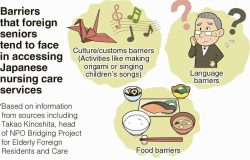
A monk walks by the 14th-century “tosu” outhouse at Tofukuji, a Zen temple in Higashiyama Ward, Kyoto. No longer in use, in former times pots to collect excrement fit in the holes, which line the walkway.
9:55 JST, August 6, 2023
The ancient capital of Heiankyo repeatedly went through disease epidemics because the population lived in cramped quarters under poor sanitary conditions.
Systems to dispose of trash and treat human waste had yet to be established. Garbage, for example, was either buried or flushed into rivers.
Compared to Nara, then called Heijokyo, the sanitary conditions in Heiankyo, what is now called Kyoto, were better because of the presence of large rivers like the Kamogawa. More than 10 canals were also created to facilitate the transport of goods and tackle garbage issues, but trash continued to remain in these waterways.
The more serious problem was human waste. Aristocrats used chamber pots, but it is unclear whether estates had special spaces for them. The chamber pots were usually placed in a corner of a room set off by a screen.
Servants washed the chamber pots in a waterway drawn from a river. The odors went downstream with the human waste. At the very least, it seems the sanitary conditions were better than in other major cities in the pre-industrial era, such as London and Paris, where excrement was thrown out of windows.
As an aside, in “Konjaku Monogatarishu” a collection of stories compiled in the late Heian period (794-late 12th century) there is a story about a nobleman named Taira no Sadafun. He sought to give up his love for a court lady who had treated him coldly. To help him tamp down his affection, he thought he should see and smell what was inside her chamber pot. So, he stole her chamber pot from the servant who was about to wash it. He looked inside and what he saw and smelled were perfumed materials set in the shape of feces.
Anyway, in those days, commoners could not afford chamber pots or have servants look after them.
In the collection of the Tokyo National Museum is a “Scroll of Hungry Ghosts” from the late Heian period, where people of all ages are depicted relieving themselves on the side of the road without embarrassment. The humans are wearing geta taller than ordinary ones to avoid soiling themselves.
Commoners during this period were said to have relieved themselves outside town or behind walls that separated residential areas from streets, but this scroll shows them doing so on the side of the road.
From the Kamakura period (late 12th century to 1333), conditions improved with the introduction of outhouses. The remains of family and public outhouses have been found.
The outhouse in Tofukuji, a Zen temple in Higashiyama Ward, Kyoto, is the oldest in existence in Japan, dating to the 14th century. Two rows of holes, each about 30 centimeters in diameter, were originally partitioned off. This outhouse is no longer in use.
Public toilets then also began appearing in Kyoto.
In the National Museum of Japanese History’s Otsu-hon version of “Scenes in and around the Capital,” the painted folding screens depict Kyoto in the latter half of the 16th century. There is a hut on the street, which is a bit shorter than a person’s height. This hut is a public toilet.
In a comparison of Japanese and European cultures published in 1585, Portuguese missionary Luis Frois wrote: “Our toilets are located behind our houses, out of sight. Their toilets are in front of the houses and open to all.”
The late Yasuo Takahashi, who was a professor emeritus at Kyoto University and an authority on Kyoto’s urban history, once said, “To create anything in the public sphere, a community was necessary to manage it.”
In the mature city of Kyoto, there were social groups based on geographical ties called “cho,” according to Takahashi, who died in April. Where houses of a cho faced each other across a road, the public toilets would be set up in the middle of it.
"JN Specialities" POPULAR ARTICLE
-

The Japan News / Weekly Edition (12/12-12/18)
-

Noodle Dining Shunsai / Rich Oyster Ramen to Savor at Odasaga; Experienced 68-year-old Owner Creates Numerous Ramen Varieties
-

The Japan News / Weekly Edition (12/5-12/11)
-

People Keep Loved Ones’ Ashes Close in Special Jewelry, Small Urns as Unique Way to Memorialize Them
-

The Japan News / Weekly Edition (12/19-12/25)
JN ACCESS RANKING
-

Keidanren Chairman Yoshinobu Tsutsui Visits Kashiwazaki-Kariwa Nuclear Power Plant; Inspects New Emergency Safety System
-

Tokyo Economic Security Forum to Hold Inaugural Meeting Amid Tense Global Environment
-

Imports of Rare Earths from China Facing Delays, May Be Caused by Deterioration of Japan-China Relations
-

University of Tokyo Professor Discusses Japanese Economic Security in Interview Ahead of Forum
-

Japan Pulls out of Vietnam Nuclear Project, Complicating Hanoi’s Power Plans
























